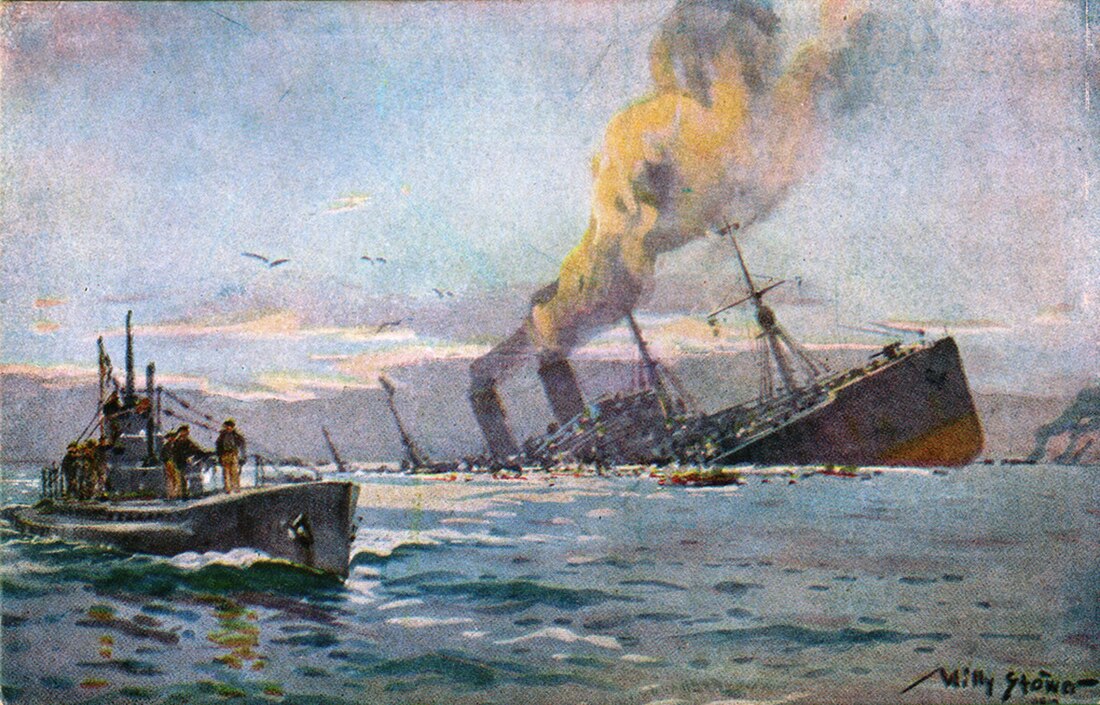SM U-73
Submarine of the Imperial German Navy From Wikipedia, the free encyclopedia
SM U-73 was one of 329 submarines serving in the Imperial German Navy in World War I. She engaged in the commerce war as part of the First Battle of the Atlantic. U-73 has the distinction of being responsible for planting the underwater mine that later led to the sinking of the largest ship sunk during World War I, the 48,158 tons hospital ship Britannic.[8]
 Willy Stöwer: sinking a troop transport by a German submarine in the Mediterranean, postcard from 1917 - missions such as U-73 offered motifs for marine painters | |
| History | |
|---|---|
| Name | U-73 |
| Ordered | 6 January 1915 |
| Builder | Kaiserliche Werft Danzig |
| Yard number | 29 |
| Launched | 16 June 1915 |
| Commissioned | 9 October 1915 |
| Fate | Scuttled during the evacuation of Cattaro 30 October 1918 in position 44°52′N 13°50′E[1] |
| General characteristics [2] | |
| Class and type | Type UE I submarine |
| Displacement | |
| Length |
|
| Beam |
|
| Height | 8.25 m (27 ft 1 in) |
| Draught | 4.84 m (15 ft 11 in) |
| Installed power | |
| Propulsion | 2 shafts, 2× 1.41 m (4 ft 8 in) propellers |
| Speed |
|
| Range |
|
| Test depth | 50 m (164 ft 1 in) |
| Complement | 4 officers, 28 enlisted |
| Armament |
|
| Notes |  |
| Service record | |
| Part of: |
|
| Commanders: | |
| Operations: | 9 patrols |
| Victories: | |
Operations
Summarize
Perspective
After completion at Danzig in November 1915, U-73 was commissioned by Kapitänleutnant Gustav Sieß.[1] She joined the Kiel School, where she remained until February 1916, conducting trials and crew training. She then left for the North Sea and was attached to the 1st Half Flotilla. Her activities were monitored throughout the war by Room 40, and most of her recorded movements are based on that information.[9] Her first operational cruise began 1 April 1916, when she left Heligoland Bight, bound for the Mediterranean by way of the North Sea. En route, she attacked one steamer in the Atlantic and laid mines off Lisbon and Malta. On 27 April 1916 she laid a minefield of 22 mines outside the Grand Harbour of Valletta in which four ships were sunk: the battleship HMS Russell; the sloop Nasturtium; HMT Crownsin, sunk 4 May 1916 with the loss of 11 men[citation needed]; and the yacht HMY Aegusa.[10] On arriving in Cattaro on about 1 May (the date is uncertain), U-73 joined the Pola-Cattaro Flotilla.
The minelaying cruises of U-73 in the Mediterranean cannot be reconstructed. The battleship HMS Russell hit two of the mines and sank. On 7 October 1916 she is reported to have left Pola in Croatia, and the French put down to her the mine sunk off Cape Male on 12 October, as well as a minefield in the Gulf of Salonika, and mines in the Gulf of Athens on which two Greek ships were blown up. It seems certain U-73, still commanded by Sieß,[1] laid the mine by which the hospital ship HMHS Britannic (currently the largest passenger ship resting on the seafloor and the largest ship sunk during World War I) was lost, only one hour after U-73 laid the mine.[11] It is possible the hospital ship HMHS Braemar Castle was also damaged by one of her mines. U-73 suffered from constant machinery trouble that was common with her class. At the end of October 1918, now in the hands of Kptlt. Fritz Saupe,[1] she was scuttled at Pola in Croatia.
Summary of raiding history
| Date | Name | Nationality | Tonnage[Note 1] | Fate[12] |
|---|---|---|---|---|
| 11 April 1916 | Inverlyon | 1,827 | Sunk | |
| 17 April 1916 | Terje Viken | 3,579 | Sunk | |
| 27 April 1916 | HMS Nasturtium | 1,250 | Sunk | |
| 27 April 1916 | HMS Russell | 14,000 | Sunk | |
| 28 April 1916 | HMY Aegusa | 1,242 | Sunk | |
| 4 May 1916 | HMT Crownsin | 137 | Sunk | |
| 3 August 1916 | HMS Clacton | 820 | Sunk | |
| 9 August 1916 | Lorenzo Donato | 140 | Sunk | |
| 24 October 1916 | Propontis | 700 | Sunk | |
| 31 October 1916 | Kiki Issaias | 2,993 | Sunk | |
| 14 November 1916 | Burdigala | 12,009 | Sunk | |
| 20 November 1916 | Spetzai | 788 | Damaged | |
| 20 November 1916 | Sparti | 961 | Damaged | |
| 21 November 1916 | HMHS Britannic | 48,158 | Sunk | |
| 23 November 1916 | HMHS Braemar Castle | 6,318 | Damaged | |
| 21 December 1916 | Murex | 3,564 | Sunk | |
| 23 December 1916 | Thistleban | 4,117 | Sunk | |
| 4 January 1917 | Peresvyet | 13,500 | Sunk | |
| 12 March 1917 | Bilswood | 3,097 | Sunk | |
| 29 September 1917 | R 235 | 15 | Sunk | |
| 30 September 1917 | Midlothian | 1,321 | Sunk | |
| 30 September 1917 | Nicolosa | 50 | Sunk | |
| 1 October 1917 | Ludovicos | 50 | Sunk | |
| 19 October 1918 | Almerian | 3,030 | Sunk |
References
Bibliography
Wikiwand - on
Seamless Wikipedia browsing. On steroids.
